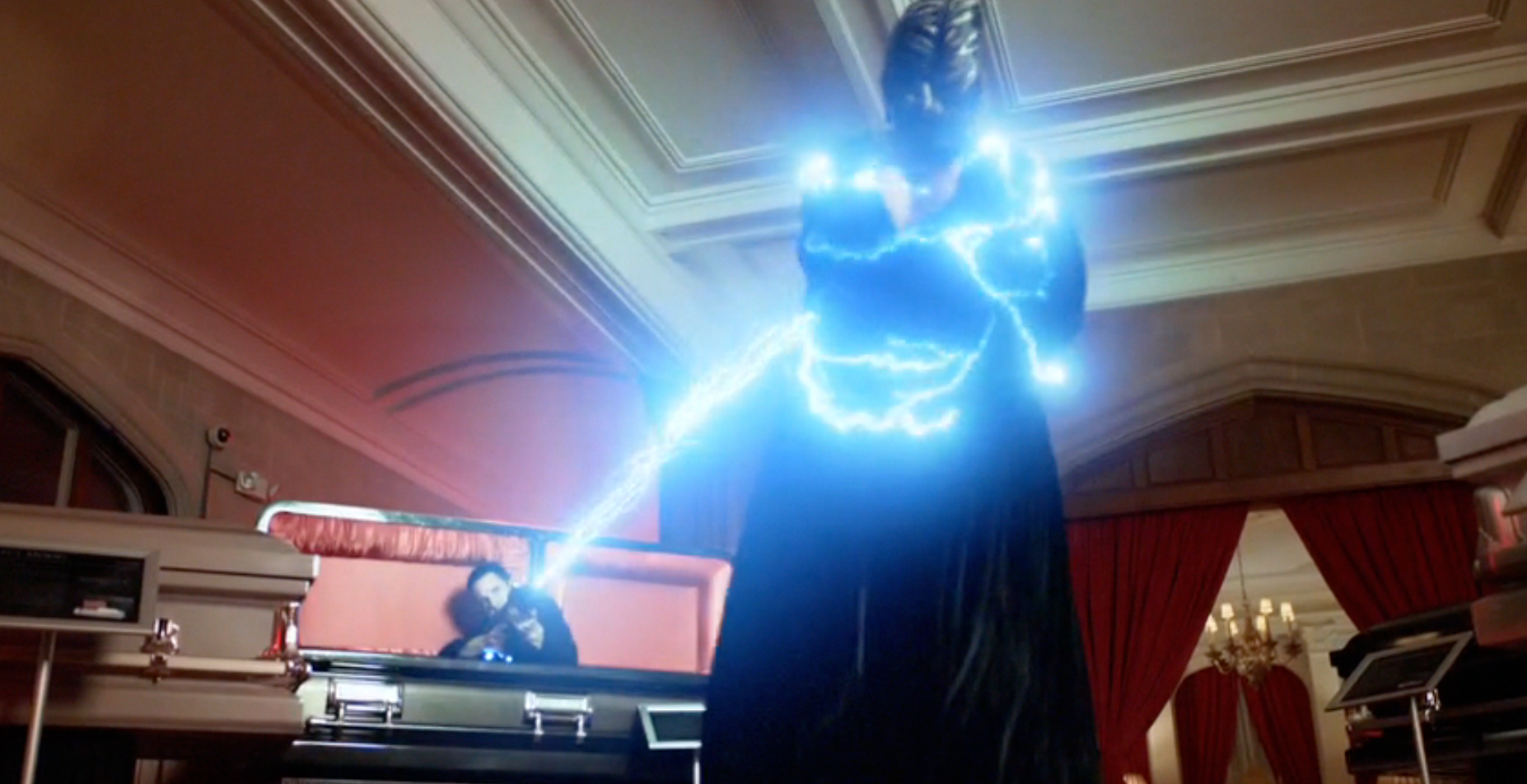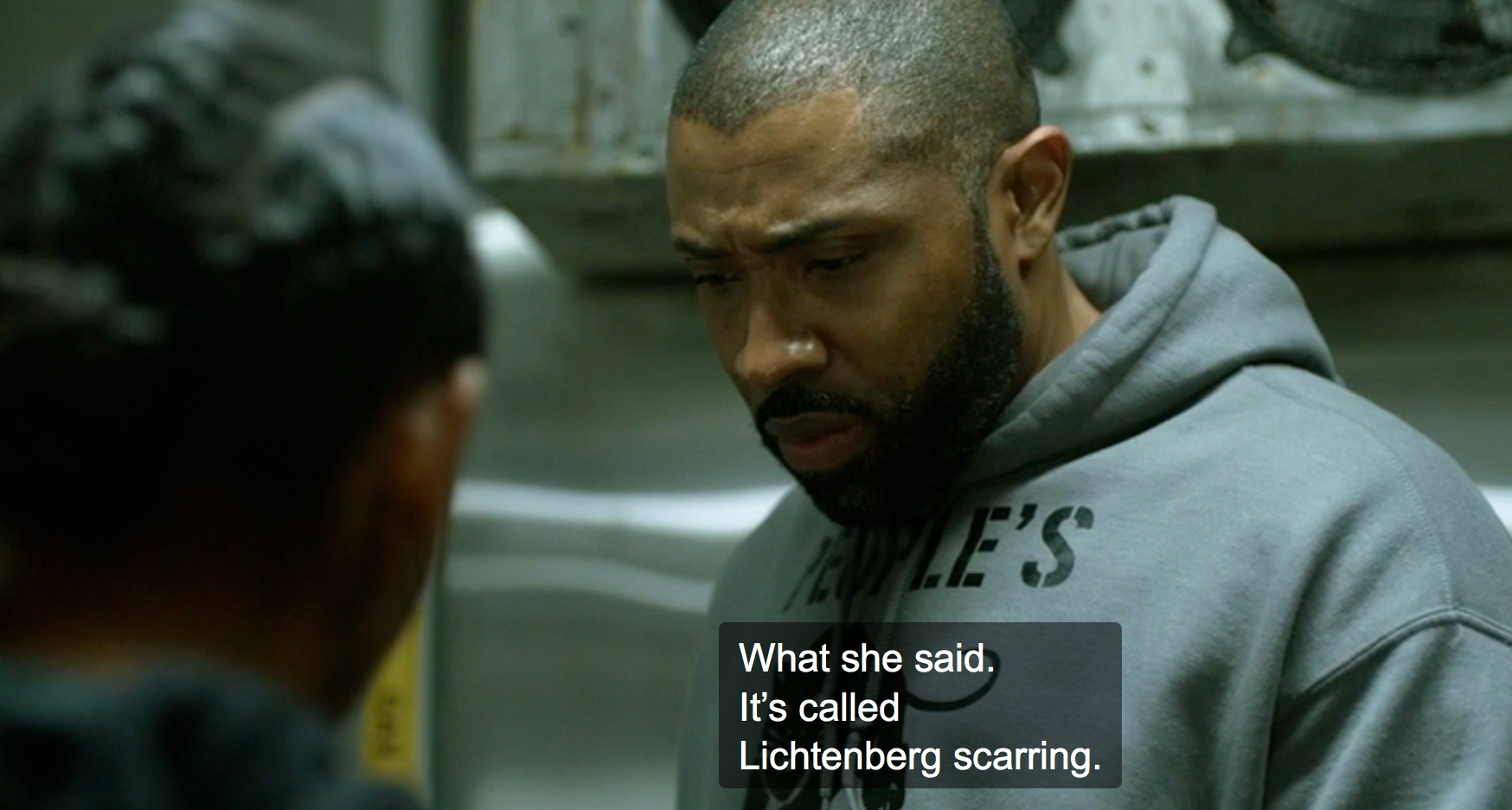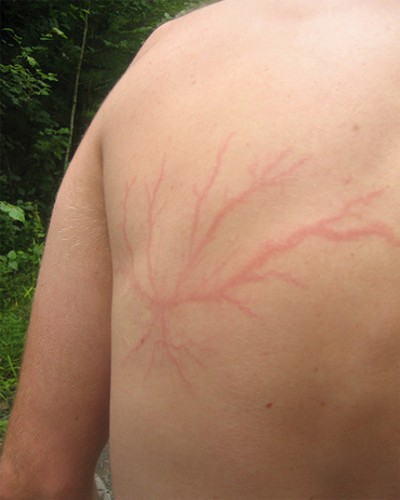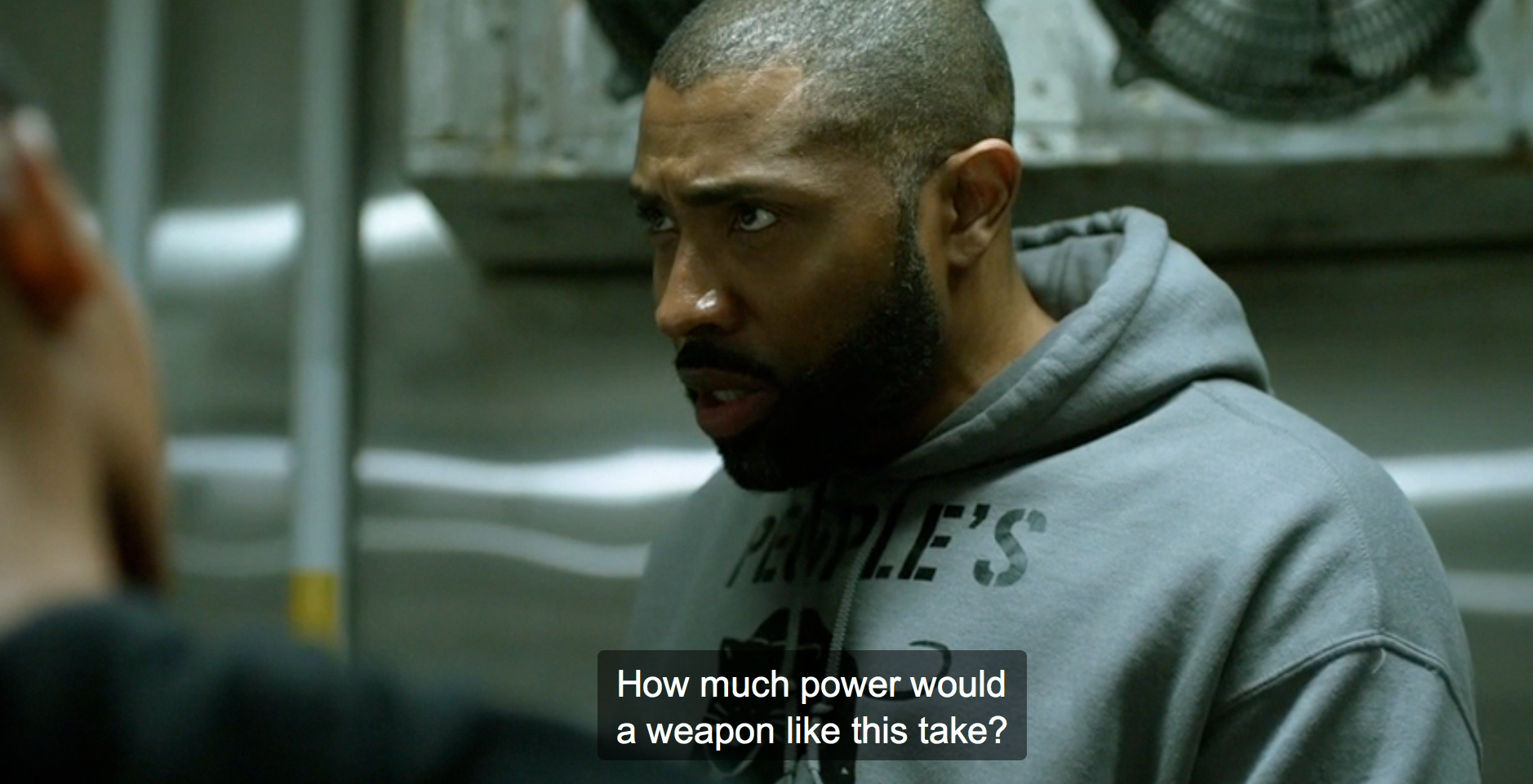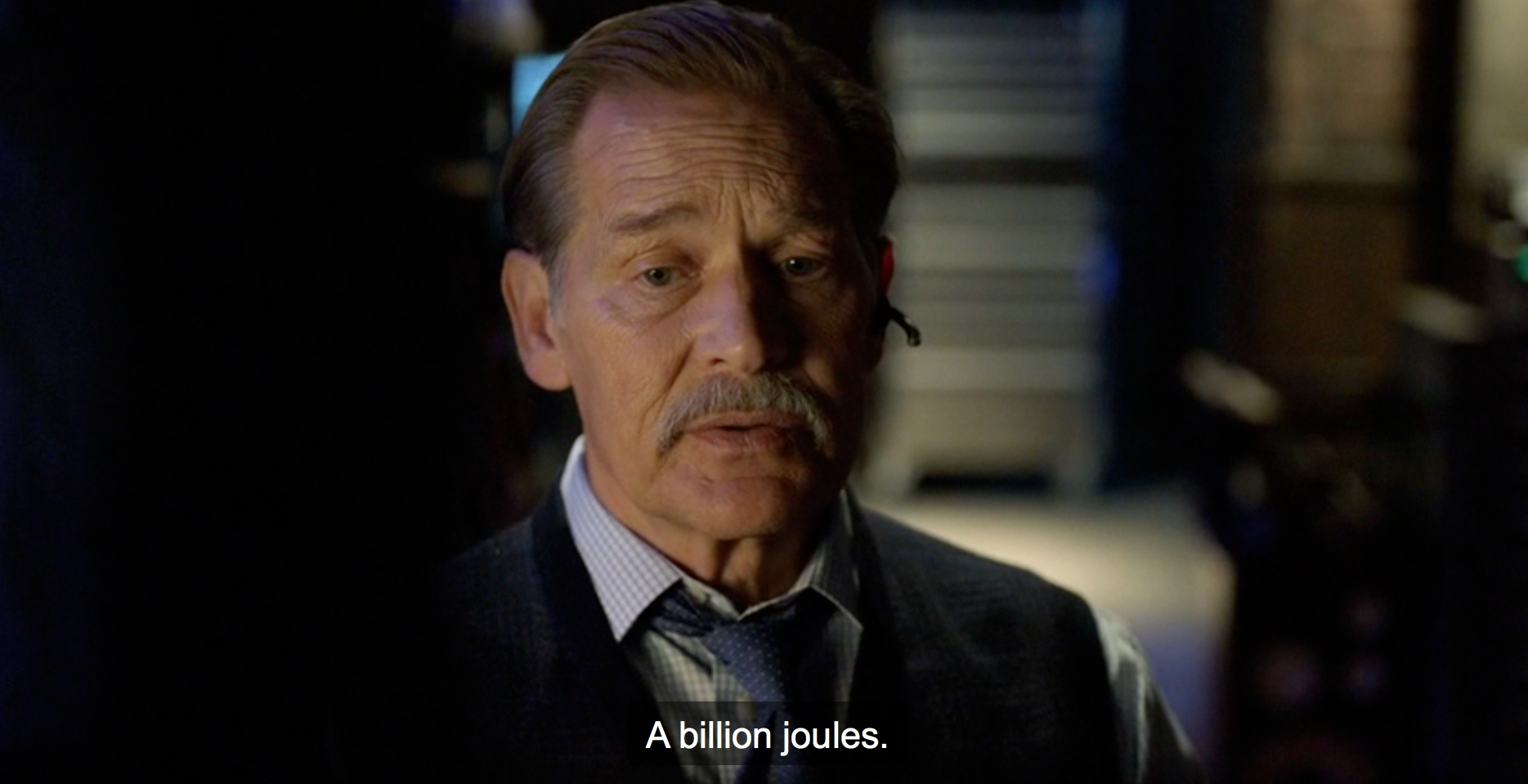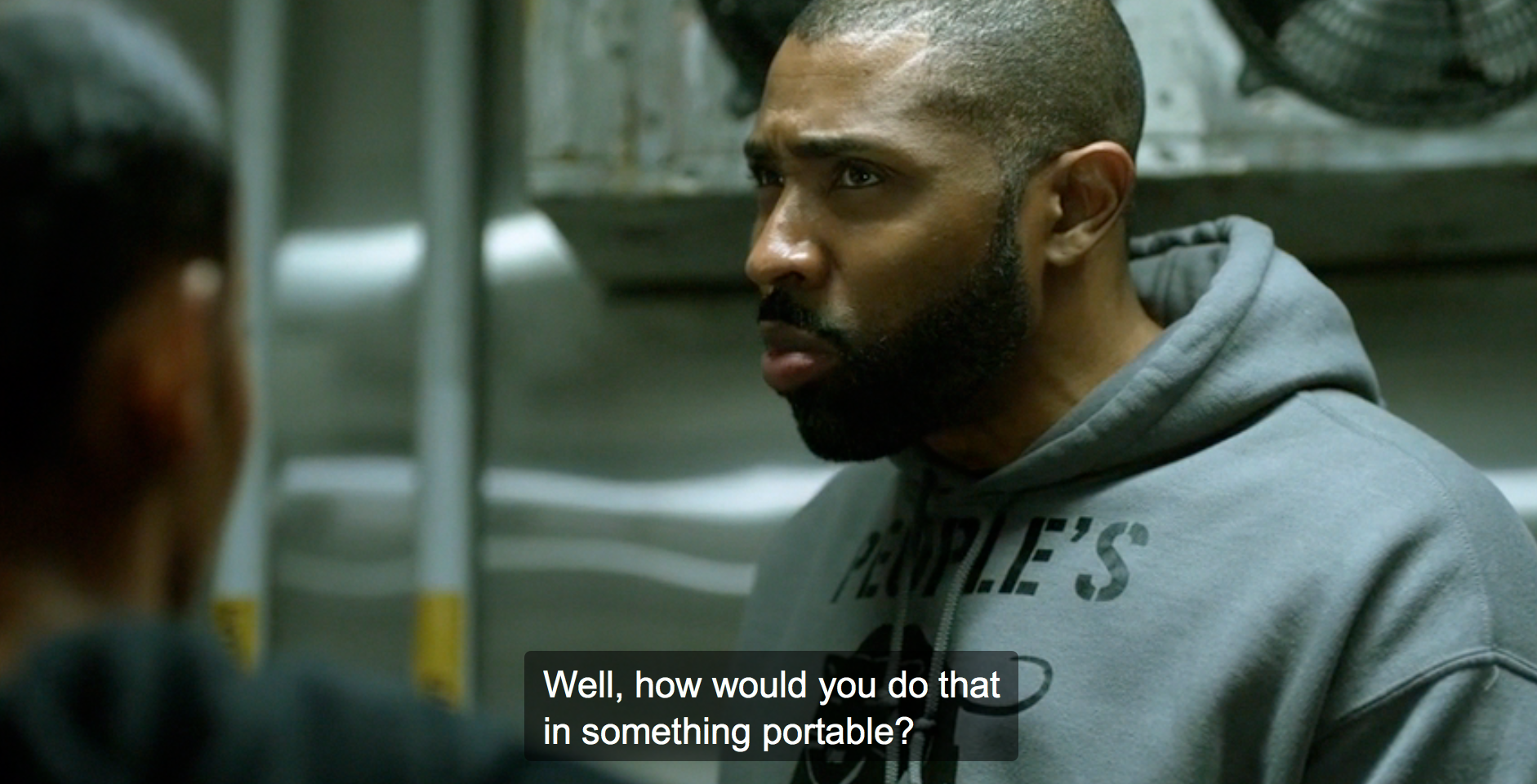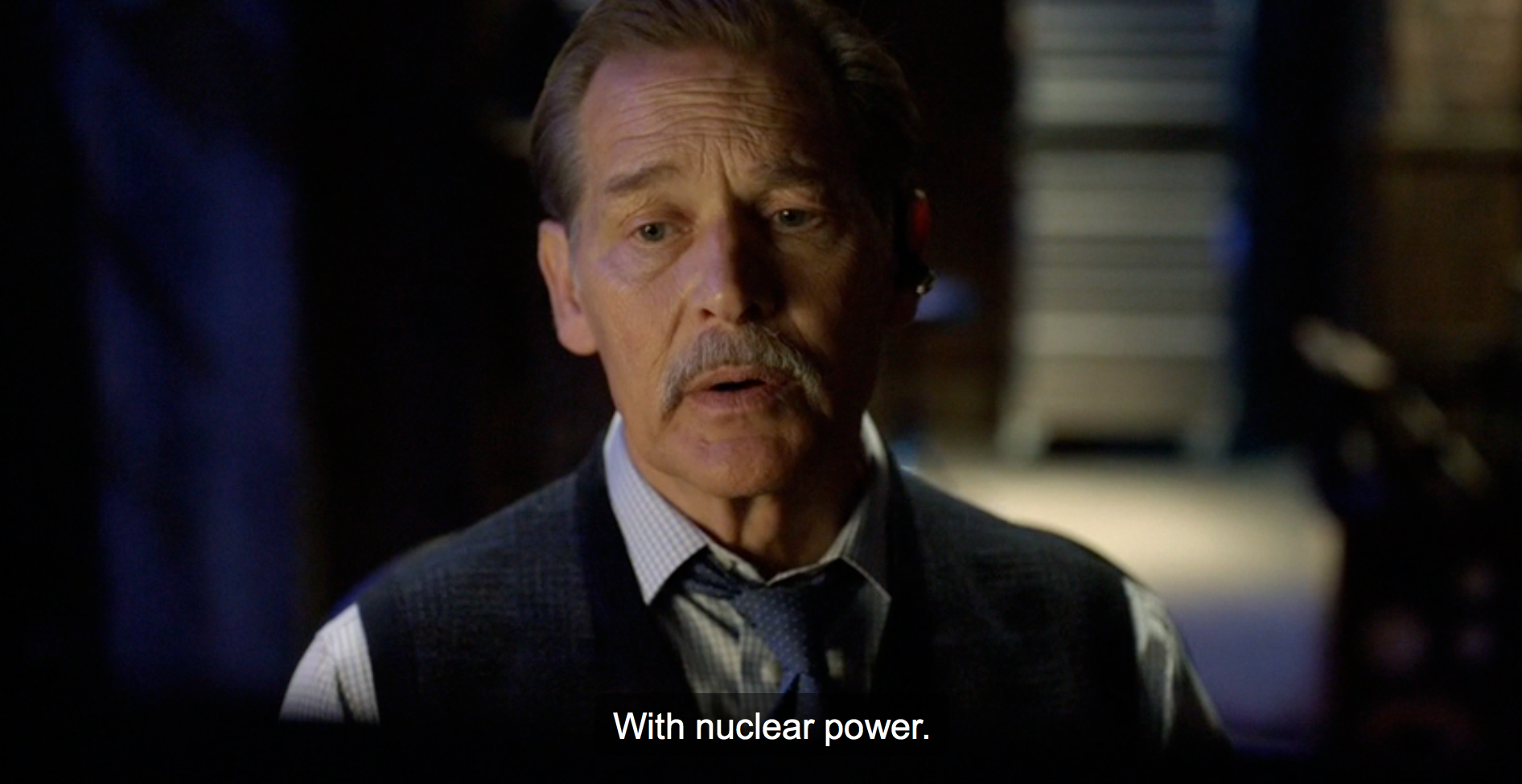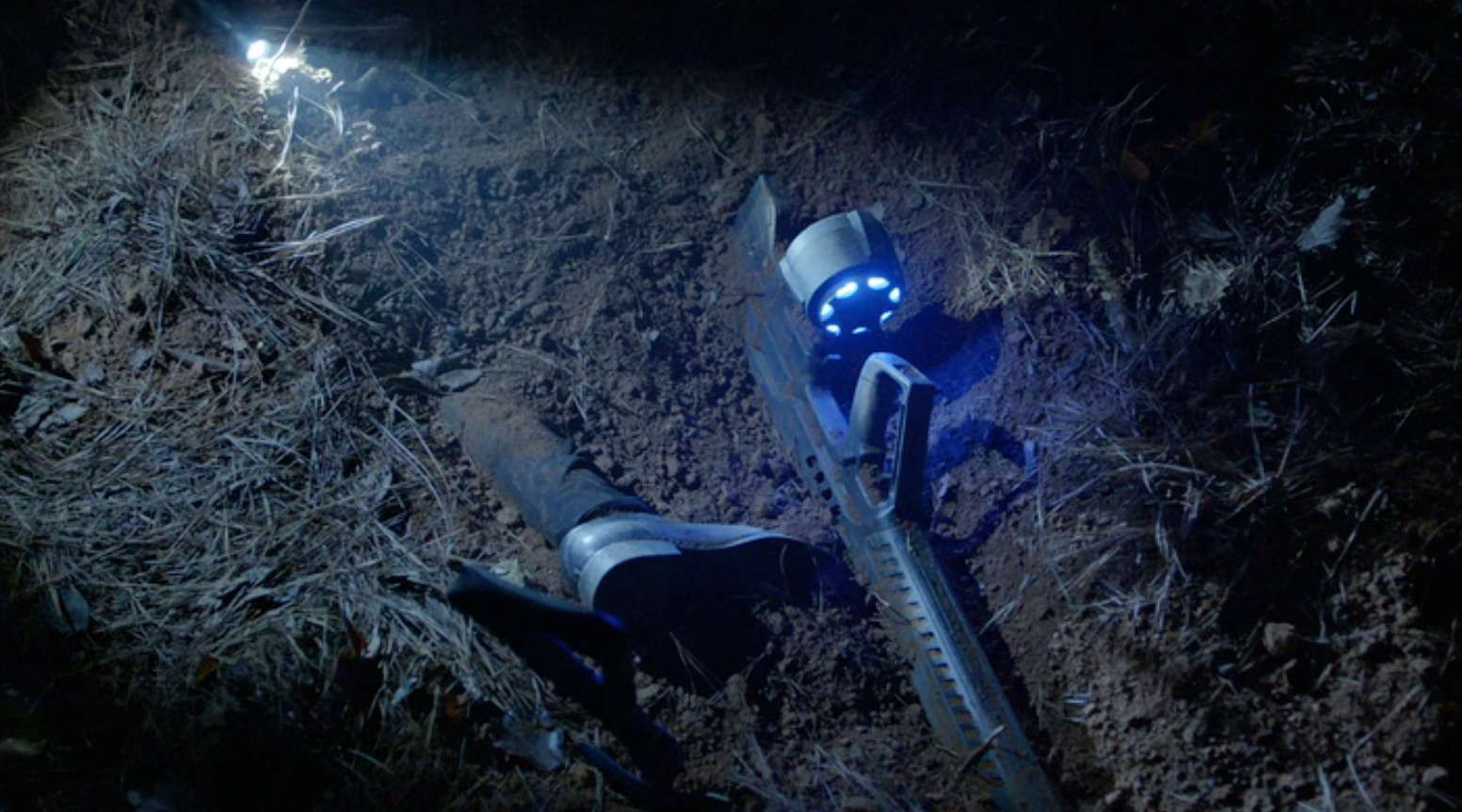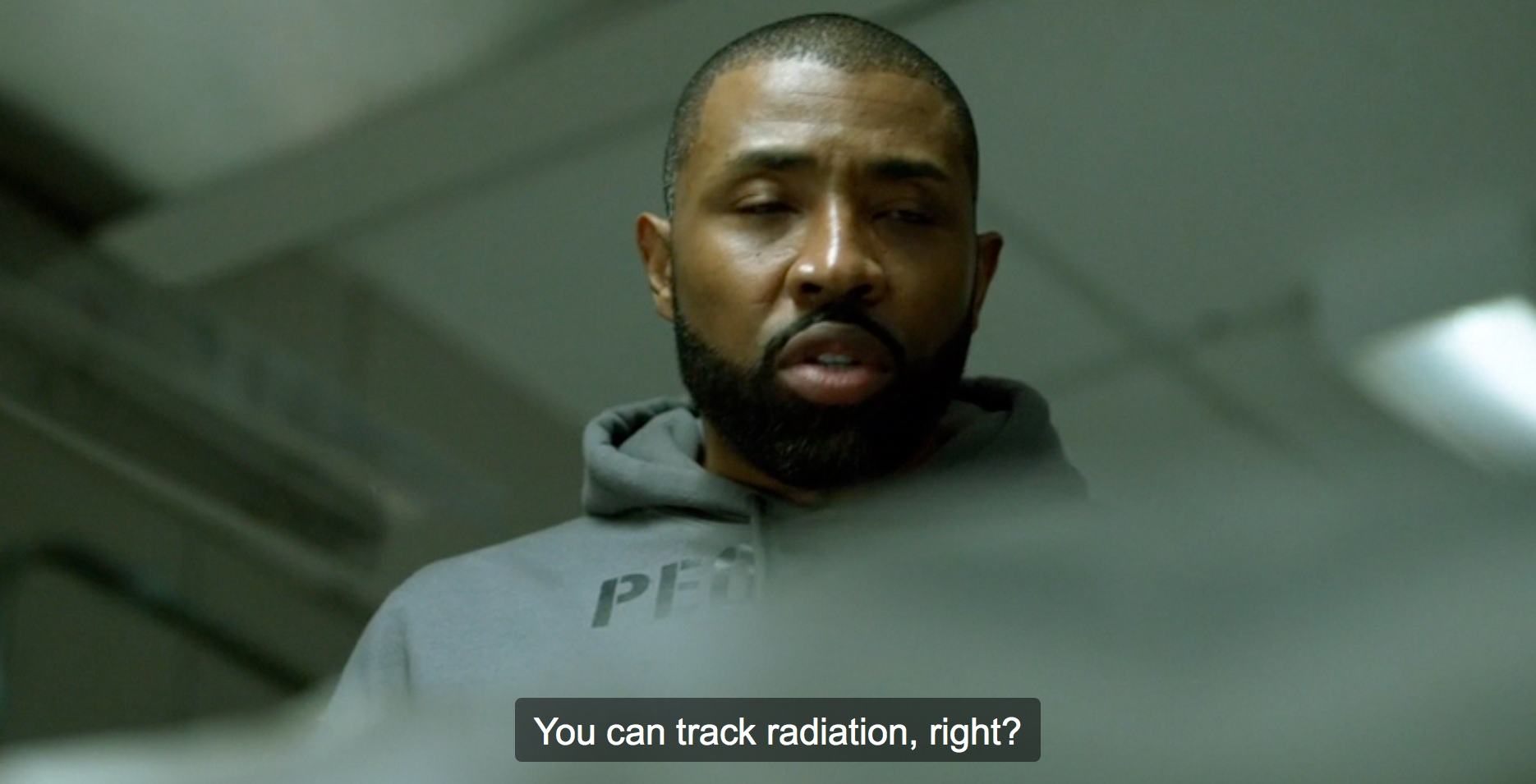A billion joules is a lot of energy. A lot. Let’s not forget that. And if nothing else, the CW’s Black Lightning is about energy. Lot’s of it. Electrical energy, sure. Kinetic energy, Yep. And a whole lot of stored up potential energy in its cast and the people of Freeland.
Oh, also, Black Lightning himself, Jefferson Pierce, is a high school principal. An educator. He’s about education – teaching. So much to the point that teaching not just what he does in his day job, it’s who he is. So much so he turns an investigation in a morgue with his super-powered daughter into a teachable moment.
Okay – back to science.
The energy jargon of Black Lightning can be pretty fast and furious at times, but in some cases, it…makes sense, and holds to some nice logic.
Case in point: in episode 8 of the series, “Revelations,” Jefferson Pierce (Black Lightning) and his daughter Anissa (Thunder) are in the morgue examining Lady Eve’s body – with their “man Friday” Gambi listening and watching remotely. Lady Eve – the former crime boss of Freeland, and former-former ASA (secret government agency/black ops type people) was killed in the previous episode, “Equinox: The Book of Life,” in a way meant to frame Black Lightning.
That way? Electricity of course. If your town’s hero is known for his lightning-like electrical powers, it only makes sense, if you want to blame him for a crime, make a gun that mimics that power. And thus the lightning-launching guns of death that have popped up in Freeland.
In the case of Lady Eve, Black Lightning was blamed for the murder (he wasn’t anywhere near Lady Eve’s funeral home, where she was killed), and her body was left a burned, charred mess. When Black Lightning and his daughter, Anissa (in their civvies) are investigating, there’s a beautiful learning moment.
Upon their first look at Lady Eve’s body, Anissa notes that there’s no scarring that you’d expect to see when someone is hit with a large electrical current, such as lightning. Gambi, watching the phone video and listening in from his workshop, agrees, saying:
As I’ve talked about before when looking at the science behind Black Lightning, Lichtenberg scarring is a human-form of Lichtenberg figures – a branching pattern produces as electricity moves through an insulator, finding the path of least resistance. When lightning hit humans, the pattern is produced by electrical currents travelling through the circulatory system near the skin. As Anissa pointed out, Lady Eve’s body didn’t have the marks. “If she had been killed by a lightning strike,” Anissa said. “…or a Black Lighting strike, Dad there’s be a tree pattern on her skin.”
I love the implication – that Black Lighting’s powers, or rather, the bolts with which he hits people – are like lightning for those struck. In our world, lightning strikes are survivable, and apparently, Black Lightning’s city, Freeland, has a large number of lightning strike survivors. With the mention of Lichtenberg scarring, it would be terrific to see Black Lightning’s “victims” (we’d call them criminals) identify each other by their Lichtenberg scars. A Freeland rite of passage, if you will.
Back to the exam, Anissa rightly points out that, given the condition of Lady Eve’s body – more burned than struck by lightning – this was most likely caused by a high-voltage flash. Okay – yes, lightning is high voltage. A lightning bolt can be upwards of a million volts, and reaching a billion isn’t unheard of. So while the weapon Lady Eve that was used against Lady Eve in the previous episode was high voltage, it wasn’t as high as lightning, and didn’t produce Lichtenberg scarring.
What’s a ballpark voltage to burn your skin? 500-1000 volts will do the job. As I’ve written about previously, a simple way to think about voltage (your physics teacher will not be thrilled with me) is that it’s the “push” to get through a material. The easier it is for the electricity to move through the material, the less voltage you need to make it happen. The harder it is, the more voltage you need. Also, if you’re “pushing” electricity through something with high resistance, that electrical current will slow down. Electrical current is made of zooming electrons which means they have a large amount of kinetic energy. Slowing them forces the electrons to give up some of that electrical energy, and they dump it as heat, or thermal energy.
Your skin is not a great conductor for electricity, and as a result, when it experiences a large voltage, it heats up due to the large energy volume. And it heats up quickly, throughout. This type of heating is called Joule or Ohmic (an Ohm is the unit of electrical resistance) heating, and is caused by – as I just laid out – the movement of electrical charge through a conductor. Even through a material that you wouldn’t think of as being a conductor, like human skin and tissue. In the attack, Lady Eve was hit by the electrical bolt for about 3 seconds. That’s plenty of time to do the damage that Anissa and Jeff see on her body.
By the way – Joule heating is one of the ways that individuals put to death by the electric chair die – the others involve the effects of a massive electrical charge going through the brain, the heart and the diaphragm, which would have also happened to Lady Eve. Electricity flowing through the person’s body heats it to a point where organ failure occurs. In extreme, and horrible, cases, individuals put to death by the electric chair have had their skin smoke, burn, and in some cases catch on fire.
Which, is horrible. But – let’s go back to the world of Black Lightning again – if you’re making these lightning weapons, saying they’re “an electric chair in a gun” is probably not the worst way to market them.
So – as Jeff realizes, the injuries were caused by a weapon. So he asks Gambi:
Which is reasonable. And Gambi answers with:
Which isn’t the answer to the question Jeff asked, but is the answer to the question Jeff should have asked, given that Gambi was seeing the images of Lady Eve’s burned body.
Let me explain.
Jeff asked how much power it would take a weapon to do the damage they’re looking at. Gambi’s answer was a billion Joules. To be fair, if he were in my class, Gambi would have gotten the question wrong, because he was asked about power, not energy.
Energy is measured in Joules. All types of energy, from thermal to potential to kinetic to electrical. The energy of electrical energy ultimately comes from electrons flowing, but more than that is a little past what we’re talking about today. For our purposes, we can stop at: Joules = energy.
Gambi was going to the idea that the burns he was seeing were caused by Joule heating, and estimated how much energy it would have taken to do that damage.
Jeff asked about power. Power is not energy. Power is energy divided by time, or in other words, the rate of energy transferred per unit time. When talking electricity, power = joules/second. The unit of power is the watt.
So – Jeff asked for an answer in watts, Gambi gave him an answer in joules. Not a huge deal. But it shows that everyone is thinking about electricity.
Jeff wasn’t thrown by Gambi’s non-power answer, and asked:
And Gambi answered with:
Okay – is this just hyperbole for hyperbole’s sake? You know, “Ooooo – we’re a superhero show, so we have to say ‘nuclear!’ Ooooo…?”
No. Gambi wasn’t joking.
Let’s go back and combine Gambi and Jeff’s question and answer from what we know about the attack. Gambi said a billion joules. From seeing the attack, we know that the bolt hit Lady Eve for about 3 seconds. That means that during those three seconds, she received a billion joules of energy, which resulted in her burns and death.
Wait – did I just see energy and time?
Let’s take this to the actual formula:
Power = energy/time
Power = 1,000,000,000 joules/3 seconds
Power = 3.3 x 108 Watts, or 333 megawatts
(mega = million)
Okay – that’s a lot of power. Like power-plant level power production. I wrote about this much power back when I played with some numbers in regards to how much energy it would take to cook Wolverine, and we’re back in that same ballpark. This is not battery-level energy production we’re talking about here (no, Mr. Musk, put your hand down – it’s not). To produce that much energy, you need, as Gambi said, nuclear power.
Okay – you don’t need nuclear power, you need something with a massively large specific energy (energy produced per kilogram), and in our world…that means Uranium-235, and that means nuclear.
Alright, Mr. Musk – or some amazingly advanced battery that can store and release a city’s worth of energy, and yet be small enough to carry around…but we’re going with what Gambi said, and sticking with nuclear.
How much?
I’m not going to do all the math again this time – if you’re interested, just check out the Wolverine article, but if we assume that the weapons had 100% efficiency (they don’t/can’t, but I teach physics, so I sometimes ignore complicating things to get to a larger answer), the guns would use somewhere between 2 to 5 milligrams of Uranium-235 per shot.
That would do it.
The weapon structure is shown in a later episode, and it’s pretty small.
So the fuel and the mechanism for converting that fuel into electrical energy has to fit into that small cylinder. Which brings us back to the ever-present…you know, if you have the technology to power a city and do it with something that’s about the size of a jar of peanut butter…why are you trying to be all nefarious and make money illegally? Go legit, become an energy company, and make all the money. All of it.
Anyway…back to the electrical gun, there’s one last thing we can look at: how many volts did the weapon produce?
A simple means to calculate that is to use a version of the formula for power that goes something like this:
Power = voltage * current
Voltage is measured in volts, and current is measured in amps.
Problem is, we don’t know either one. But – we do know some ballparks that can help with our estimation. Looking back at the image of Lady Eve getting hit by the bolt, she looks to be about 2-3 meters away from the gunman. Let’s call it 3 meters. So – what current did she get hit with?
Again, going back to the previous Black Lightning article, it takes about 3 million volts (3 MV) per meter to get electricity moving through the air. 3 meters? 9 million volts, give or take.
333 MW = 9 MV * current
Current = 37 amps
Is that enough to do the job?
Whoa, yes. You really kind of stop worrying about it at 10 amps – that’s enough to cause ventricular fibrillation and severe burns. 37 amps? Overkill.
So, in summary, within the internal logic and “rules” of Black Lighting, everything checks out:
- No Lichtenberg scarring – okay, high voltage, but not lightning high
- A billion joules: more than enough for the burns seen on Lady Eve’s body
- How much power – 333 MW
- The only possible source for that power? Nuclear.
- An approximate current provided? 37 amps, which is way more than enough.
Okay – anyway, showing off some more of the smart writing and personal interactions that make Black Lightning stand out, even among the CW’s other shows, Jeff asks Gambi:
As a smart way of finding out where the weapons went, and points out to Anissa how they were able to find the answer to their question without anyone getting punched or shocked:
Black Lighting on the CW. The home of superhero teachable moments.



